Intel Core i9-13900K and i5-13600K Review: Raptor Lake Brings More Bite
by Gavin Bonshor on October 20, 2022 9:00 AM ESTCPU Benchmark Performance: Power And Office
Our previous sets of ‘office’ benchmarks have often been a mix of science and synthetics, so this time we wanted to keep our office section purely on real-world performance. We've also incorporated our power testing into this section too.
The biggest update to our Office-focused tests for 2023 and beyond include UL's Procyon software, which is the successor to PCMark. Procyon benchmarks office performance using Microsoft Office applications, as well as Adobe's Photoshop/Lightroom photo editing software, and Adobe Premier Pro's video editing capabilities. Due to issues with UL Procyon and the video editing test, we haven't been able to properly run these, but once we identify a fix with UL, we will re-test each chip.
We are using DDR5 memory on the Core i9-13900K, the Core i5-13600K, the Ryzen 9 7950X, and Ryzen 5 7600X, as well as Intel's 12th Gen (Alder Lake) processors at the following settings:
- DDR5-5600B CL46 - Intel 13th Gen
- DDR5-5200 CL44 - Ryzen 7000
- DDR5-4800 (B) CL40 - Intel 12th Gen
All other CPUs such as Ryzen 5000 and 3000 were tested at the relevant JEDEC settings as per the processor's individual memory support with DDR4.
Power
The nature of reporting processor power consumption has become, in part, a bit of a nightmare. Historically the peak power consumption of a processor, as purchased, is given by its Thermal Design Power (TDP, or PL1). For many markets, such as embedded processors, that value of TDP still signifies the peak power consumption. For the processors we test at AnandTech, either desktop, notebook, or enterprise, this is not always the case.
Modern high-performance processors implement a feature called Turbo. This allows, usually for a limited time, a processor to go beyond its rated frequency. Exactly how far the processor goes depends on a few factors, such as the Turbo Power Limit (PL2), whether the peak frequency is hard coded, the thermals, and the power delivery. Turbo can sometimes be very aggressive, allowing power values 2.5x above the rated TDP.
AMD and Intel have different definitions for TDP that are, broadly speaking, applied the same. The difference comes from turbo modes, turbo limits, turbo budgets, and how the processors manage that power balance. These topics are 10000-12000 word articles in their own right, and we’ve got a few articles worth reading on the topic.
- Why Intel Processors Draw More Power Than Expected: TDP and Turbo Explained
- Talking TDP, Turbo and Overclocking: An Interview with Intel Fellow Guy Therien
- Reaching for Turbo: Aligning Perception with AMD’s Frequency Metrics
- Intel’s TDP Shenanigans Hurts Everyone
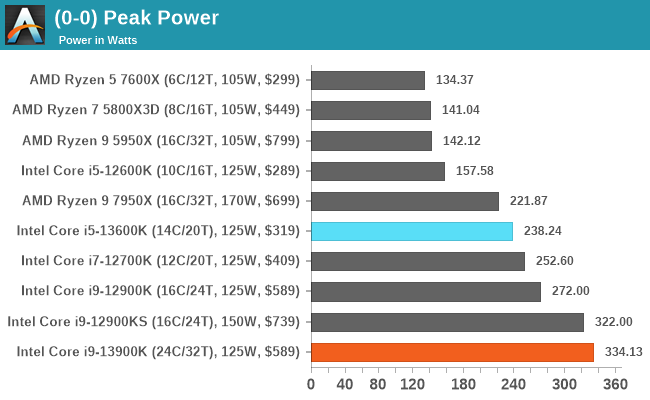
Directly digesting the peak power figures from both the Core i5-13600K and Core i9-13900K processors, the latter drew around 12 W more than the Core i9-12900KS does, and 62 W more than the regular Core i9-12900K. While additional power draw was to be expected due to the very high core clock speeds, let's not forget it is also a 24-core processor, hybrid cores or not.
Even so, the Core i9-13900K drew 32% more power than its 253 W Turbo PL2 limit, but it's very unlikely most users that are gaming or doing general PC stuff will ever see power figures like this. The key to note really with the Core i9-13900K is if it is using this power (125 W TDP to 253 W TDP = 2.02x the power) efficiently for the benefit of performance, then it makes it a less harsh pill to swallow. We would certainly recommend premium cooling with this for maximum performance efficiency.
Looking at the Core i5-13600K, this sits a bit higher than the AMD Ryzen 7950X in terms of peak power consumption, and just below the Core i7-12700K. The Core i5-13600K does draw considerably more power than its predecessor, the Core i5-12600K (157 W versus 238 W), but the increase in both core frequency and double the E-cores, is to be expected.
Looking deeper into the high power consumption of the Core i9-13900K, we can see that it is shooting above Intel's PL2 value considerably more than the previous generation. One potential reason for this is down to motherboard vendors continuing to ignore PL2 limits and optimizing for performance under a thermal limit as opposed to power.
During our testing of the AMD Ryzen 9 7950X, we saw our GIGABYTE X670E Aorus Master AM5 motherboard adhere to AMD’s PPT limit, yet with our MSI MPG Z790 Carbon WIFI, we are overshooting the 253 W PL1 limit by around 40-42% at peak figures. While we don’t believe that Intel is ignoring its own classification and specification of power limits here, we believe that the onus is on motherboard vendors to adhere to these limits. A lot of the time, motherboard manufacturers want to deliver the best possible performance out of the box it can, and while we don’t necessarily believe this is a massive negative, it does paint a picture that the Core i9-13900K has insane power draw at maximum load. A power draw that would otherwise be tempered significantly by adhering to PL2.
As we do some additional testing with the MSI MPG Z790 Carbon WIFI, we'll see if this is a specific problem with this particular motherboard, or if it’s the Z790 platform itself. We’ll also look to test some other LGA1700 models we have available, and we’ll update this analysis with our findings.
Office/Web
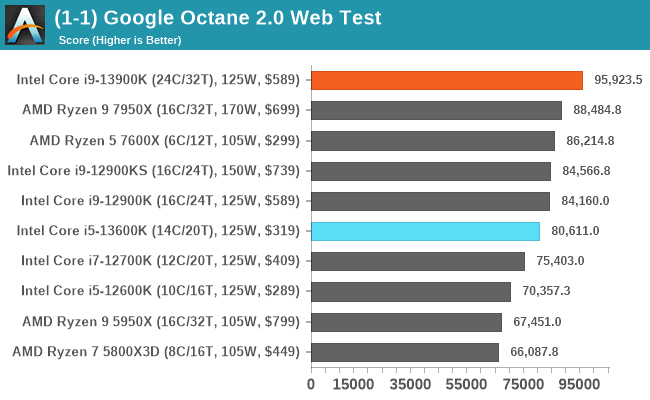
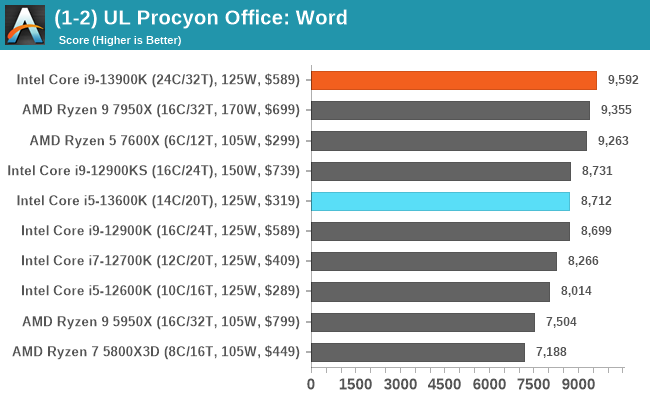
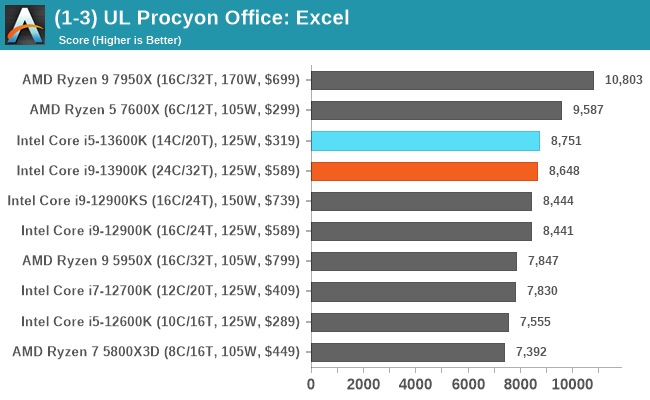
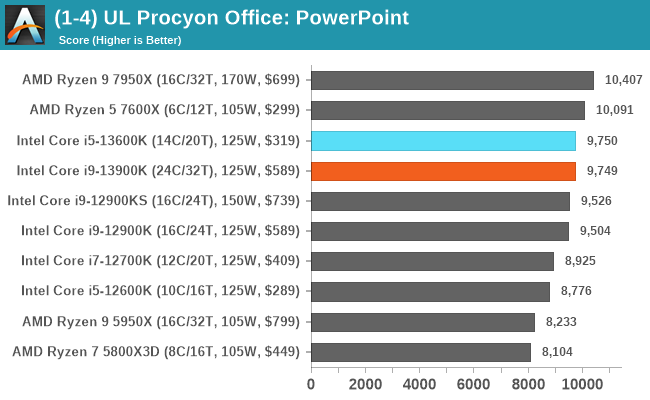

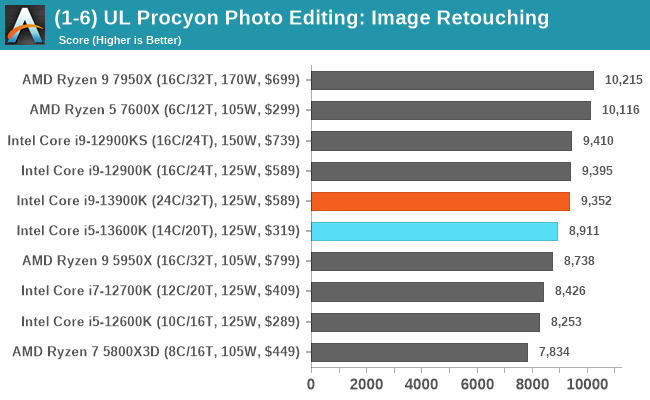
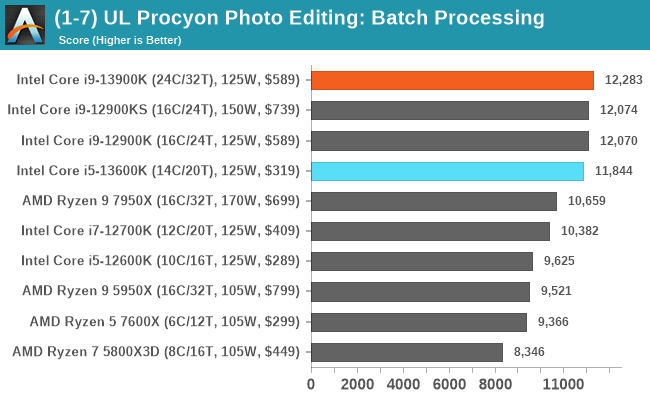
Looking at real-world web and office performance, the Core i9-13900K performs very well, and in a lot of tests, is neck and neck with the Ryzen 9 7950X. This is interesting given the Zen 4 is a new core on a new 5 nm process, and the Intel 13th Gen Core is a refined Intel 7 (10 nm) solution. The Core i5-13600K also performs competitively, and even the previous generation Core i9-12900KS are also in the thick of things.


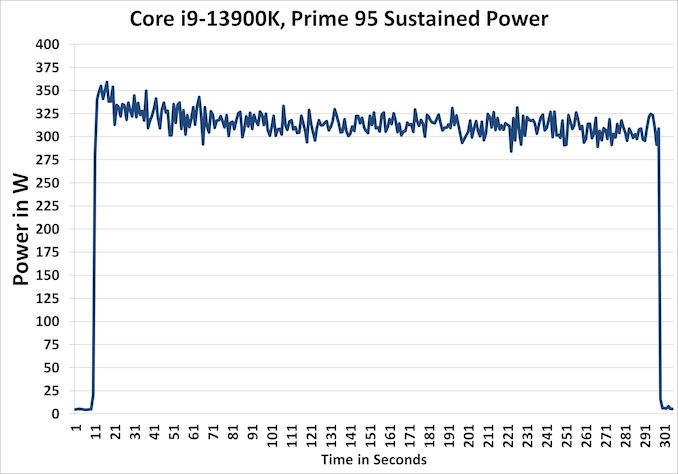








169 Comments
View All Comments
nandnandnand - Monday, October 24, 2022 - link
I can see a couple of things that make sense:1. Buy onto the platform early, upgrade very late. Like 1700X to 5800X3D. Except that didn't work for every motherboard on AM4.
2. Buy a budget chip, upgrade to an expensive chip 1+ gen later. The Ryzen 5 7600X is currently the cheapest but at $300 it doesn't really qualify.
Nobody should buy AM5 or Raptor Lake (new system) right now. Wait for 7800X3D/Zen5 and Meteor Lake. Reply
Kangal - Monday, October 24, 2022 - link
This.Initially the r7-1700 and x370 offered mixed value, and the upgrade path looked great. But AMD wasn't able to properly fulfil their AM4 promise.
So perhaps AMD realised their issues, and fixed things for AM5. So perhaps but the most expensive motherboard and the best value cpu to upgrade the cpu later. Or maybe nothing has changed, since AMD is so far ahead of Intel when it comes to motherboard relevancy.
So for new system builders, you can blow the budget and go all-in on a new Intel + Nvidia tower. For the best value builders, customising an older AMD (5800x3D) and RDNA is the way to go. For the risk takers, you can overpay for things that are going to last, and cut-back on things you know yobare going to upgrade (gpu, cpu, more storage).
Reply
GeoffreyA - Tuesday, October 25, 2022 - link
The promise of upgrading is great, but sometimes doesn't work out as planned. I built a 2200G + B450 Tomahawk in 2019, with the hope to upgrade to a 6-core APU later on. Now, the 5600G is the one to go for, but has considerable issues when joined with the Tomahawk. So, I tend to think I'll just wait for a whole new system, AM6 perhaps, who knows? Replytvdang7 - Sunday, October 23, 2022 - link
Is it to much for the reviewer to add the 7900x and 7700x into the graphs just so we know what we are dealing with ? ReplyRyan Smith - Monday, October 24, 2022 - link
We do not currently have those chips. AMD has only sampled the top and bottom SKUs.We'll get them eventually through other means. We just don't have them right now. Reply
o01326 - Sunday, October 23, 2022 - link
Just signed up to comment this: why are you benchmarking Civ IV by FPS? ReplyTheinsanegamerN - Monday, October 24, 2022 - link
The same reason they were, up until this review, still using a 2080ti for their CPU gaming benchmarks. Replycoolkwc - Monday, October 24, 2022 - link
this review is failed, don't even post what's the core temperature under stress? So difficult to get that reading huh? ReplyAnnnonymmous - Monday, October 24, 2022 - link
Transient power spikes with an RTX 4090 and 13900K mean you will need at LEAST a 1500w power supply to prevent random computer shutdowns. That's crazy! Of course, this will only happen when you are running a game 4K, Max Settings, with Ray Tracing enabled. Still, getting 1,000-1,200w spikes is crazy! Replytrueonefix - Monday, October 24, 2022 - link
Awesome Reply